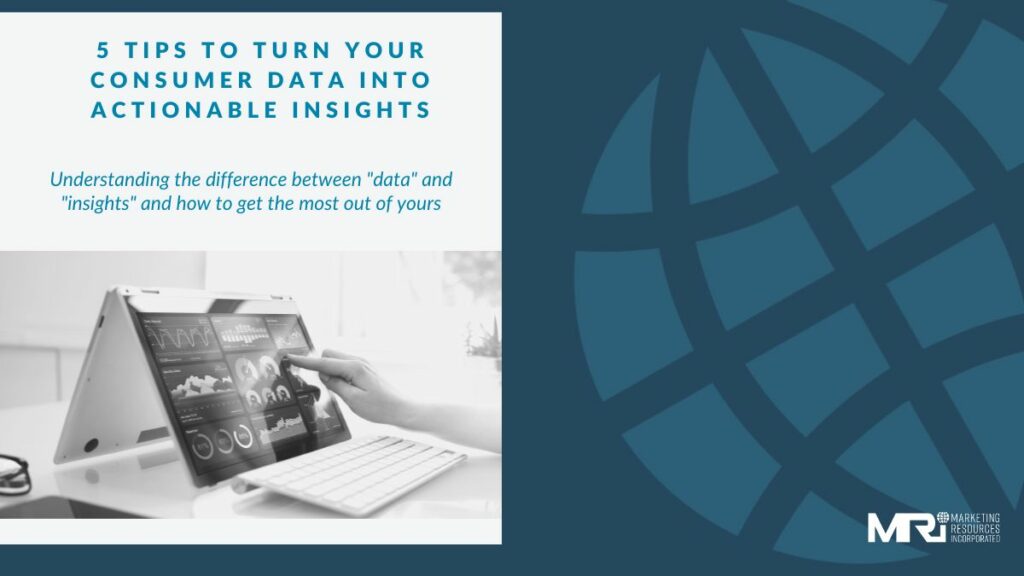“Actionable insights” has become such a ubiquitous phrase, at this point, it should be lumped in with other corporate jargon like “synergize,” “circle back to that next week,” and “let’s take this offline.” Its overuse has nearly stripped it of any meaning. A slick salesperson might shout until they’re blue in the face that their product or service will provide you with “valuable data,” but, so does every other salesperson you speak with, so what does that even mean?
Your customer data is only as valuable as you make it. You can have dozens of spreadsheets full of information about your contact lists, but if you don’t put that data to work for your brand, it’s useless.
Turning customer data into actionable insights, therefore, requires your brand to analyze it, and adjust your strategy based on your analysis. Unfortunately, most of those salespeople who promised such insights are long gone before it becomes time to transform data into insights, leaving your brand left to do the hard work alone.
At MRi, a leading promotional marketing agency, we approach data, value, marketing promotions, and your brand a little differently than you might be used to. Our unique, 4-step Big IDEA process centers your brand and its goals, guiding you through each step of running an effective campaign.

The Difference Between Data and Insights
“Data” is any raw information you have. Data comes in various forms like numerical, text, audio, image, and so on. Data is simply an unprocessed, unmanipulated fact.
An “insight” on the other hand, is extracted from data. Insights are gathered through the close analysis of raw data, allowing you to understand its context and draw conclusions. The conclusions you draw allow you to make informed decisions regarding your brand.
Remember: Data leads your brand to insights. You can’t have an insight without first gathering data.
Giving Your Data Meaning
Whether you’ve just generated new leads via a promotional sweepstakes, you’re enriching your customer data with information you’ve gathered from a loyalty program, or you’ve captured data in some other method, it’s just waiting to tell you a story.
Your brand won’t be ready to hear those stories until you first identify its purpose. Why does your brand exist? What value do you provide to your consumers? What are their expectations of your brand? What do you hope to do better?
Your brand must first understand your goals, targets, opportunities, and challenges in order to develop a business strategy and make sense of raw customer data. With this context in place, and only then, can you begin to gather data and extract value from it.
Collecting The “Right” Data for Your Brand
Now that you’re ready to collect data to guide your brand, it’s important to plan how you collect that data. Different methods of collection will yield different types of data. Not all data is created equally. Remember, it’s only as valuable as you make it.
MRi’s Vice President of Marketing & Client Strategy, Adam Davis, notes “different types of marketing promotions open up your brand to different types of data. Brands want to make sure they are starting and ending with running the right promotion to gather the right types of data.”
For example, a sweepstakes campaign commonly yields information like a user’s name, basic demographics, and contact information. This can be helpful for brands looking to grow their audience and expand their outreach, but wouldn’t provide much value to a brand looking to understand their audience on a deeper level. For brands who wish to collect data in order to connect with their consumers, a loyalty program that collects historical data on consumers over time, or a contest that asks consumers to share their stories might provide more value.
Always keep your brand’s purpose top-of-mind when deciding how to most appropriately gather data. Better yet, consult with an expert as you strategize and develop your next data collection campaign.
How To Turn Your Customer Data into Insights
- Ask The Right Questions
When gathering data, it’s important to ask targeted questions based on your identified purpose. While running a promotional campaign like a sweepstakes in exchange for consumer data may seem like a great time to ask every single question you’d like to ask, keep your efforts specific and focused on your purpose.
For example, imagine a QSR brand has identified that they’d like to deepen their connection with their consumers and build loyalty. Before they can do so, they should first take steps to understand the values and needs of their target consumers by gathering data on them.
With this in mind, it would be prudent to ask specific questions about what motivates consumers, why they choose one brand over another, which social movements matter to them, etc. Avoid asking too many questions when gathering data, so as not to bore participants.
Part of asking the right questions is also avoiding “the wrong questions.” We’re sorry to all of the teachers out there who’ve said “there’s no such thing as a wrong question,” because in this case, there is. When gathering data about your consumers, it can be easy to get “swept up” in the enormity of information available to you. This can lead to inaccurate or useless data tainting your analysis. Don’t ask questions you already know the answers to, otherwise, you’ll waste time and money uncovering “insights” that are common knowledge.
- Make Note of Patterns and Anomalies
Identifying patterns and anomalies within your dataset can clue you into some valuable insights. Correlations within data suggest recurring themes or sentiments that your brand will want to keep in mind.
Are you noticing products at a particular price point sell at a higher rate than any other price? One simple conclusion you can draw from this pattern is that price, whatever it is, compels more consumers to purchase than any other. The actionable insight from that conclusion? Place more products at that price point.
Are several of your consumers reporting that they’re experiencing the same positive emotion after interacting with a particular page on your website? Draw the conclusion that the UX of that landing page is optimized and more effective at pushing consumers through your marketing funnel, and take the action to replicate that page’s experience across the rest of your site.
Anomalies, deviations from the norm, can reveal just as much value to your brand as patterns in data. Anomalies in data are useful in identifying and understanding unusual situations or experiences. For instance, imagine that, according to your data, all but one of your retail locations have seen success enrolling new customers into a loyalty program. What conclusions can you draw in this situation? Maybe that location doesn’t fit your target audience demographics, or maybe the benefits and rewards your loyalty program offer don’t motivate this region enough, to name just a few.
Anomalies will usually require further investigation in order to adequately address and understand them, but taking note of them as soon as possible will help your brand transom data into insights sooner.
- Verbalize Your Findings
As soon as you’ve collected your data and have organized it, help make sense of it by verbalizing it with multiple decision-makers and stakeholders. Not only can other team members help identify significant data that you may have missed, but they can also provide a fresh perspective and offer greater context to data.
Communicate your methods for gathering the data, the data itself, and what your goals are in uncovering these insights. This will help keep all stakeholders on the same page, and ensure that you maximize the value of the data you collect.
- Rely on Multiple Data Sources
When it comes to collecting data to develop your business strategy, the more the merrier. You’ll want to make sure that the data you collect and analyze is large enough to be considered statistically significant. This means the pool you sampled is representative of your general target audience (for example, if your target audience is older adults, make sure you gather information from them and avoid surveying teens) and includes a large number of samples.
Increase the amount of data you collect by including multiple sources of data. Social media surveys, purchase history, post-purchase surveys, OCR receipt scanning, and several other sources of data can support your brand as you continue to make informed decisions.
- Hire a Trusted Partner
At the end of the day, transforming raw data into valuable insights is a necessary step you must take in order to make informed decisions for your brand.
When you’re dealing with such large sets of data, numerous stakeholders, and a multitude of different marketing objectives, things can quickly become overwhelming. Working with a trusted partner like MRi allows you to delegate tasks to industry experts who’ve done this before.
Your Data Transformation
A recent Forrester report found that up to 73 percent of all data never gets properly analyzed by the companies that gather it. These companies have goldmines within their spreadsheets and they’re not even tapping into it! Imagine throwing away 73 cents of every dollar you made.
That would still cost your company less than ignoring the value that lies in your data.
Whether you’ve clearly identified your marketing targets or need some help identifying your brand’s purpose, MRi is here to help you every step of the way. Our decades of experience guiding some of the world’s most recognizable brands make us a reliable consultant for your brand.
Schedule a free consultation with one of our data experts and start unlocking valuable insights for your brand.






